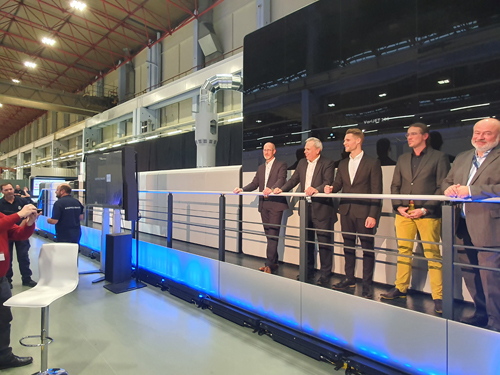An article by Sean Smyth, Smithers.
It takes confidence to show off a new mainstream digital press. And when you show your proven new generation Rapida 106 offset machine running at 20,000sph first, in combination with the 15,000sph B1 CutProX rotary die-cutter to a bunch of analysts and journalists there is a high degree of bravado. And that is what Koenig & Bauer Durst did as they proudly showed off some stunning new technology in Radebeul recently with the B1 seven-colour VariJET106.
It is a sizeable piece of kit, built to stand the rigours of mainstream production at traditional offset carton converters. The configuration on show combined proven Koenig & Bauer sheet transport with Durst inkjet and inks. The press features a non-stop feeder into a priming unit with drier, then the seven-colour inkjet print engine, high resolution camera, drier, a conditioning unit into a coater and further drier and then into a continuous delivery stacker. This is 28m long excluding the press console. The highest part is the inkjet engine which reaches 4.1m high to house the cleaning and capping station for when the heads are not in operation. It weighs 21 tonnes, necessary to provide the reliability demanded by Koenig & Bauer customers, truly a heavy metal digital press. The heads are Fujifilm Dimatix Samba, using food accredited water based inks. The seven colours are cyan, magenta, yellow and black with orange, green and violet to widen the gamut to more than 90% of the Pantone range. The demo jobs included reflex blue, bright oranges and greens with a clean PMS032 red for good measure. Nice clean and sharp results, dry and excellent registration even in fine reversed text – and I couldn’t find and missing lines or artefacts despite looking hard.
The demonstration showed five jobs run in a ten minutes, admittedly on the same board, but there was a spot varnish changeover to accommodate the different glue flap patterns. They then brought the sheets out to our socially distanced table and they were flat, dry and pretty good with a range of spot colours from reflex blue to bright greens, oranges and even warm reds. And I couldn’t find any lines or inkjet artefacts despite hunting them with my trusty loupe. One of the advantages of Koenig & Bauer’s portfolio is their machinery is used in many sectors and they can transfer technology from their specialities. Koenig & Bauer is strong in security printing where quality assurance is paramount and they are using very high resolution measurement equipment from currency presses to check every nozzle’s performance in real time and correct defects to allow the machine to keep printing. Modern sheetfed offset presses feature sheet monitoring, but not at sufficient resolution to control 1200dpi inkjet output. Koenig & Bauer and Durst are synonymous with good print quality and this machine delivers that.
Robert Stabler, Managing Director, Koenig & Bauer Durst, explained that the camera detection system was developed for Koenig & Bauer security presses as 1,200dpi resolution was too high for most existing inspection systems to measure. While requesting no photography of the inkjet unit (there are features currently being patented) they invited me to look inside the glass structure. There is a lot of space with raised sheet detectors able to stop sheets colliding with the heads, and the head cleaning and capping station is above the printing position rather than to the side. The sheet transport is a heavy duty metal vacuum belt, capable of taking B1 sheets at 5,500sph from the traditional offset grippers, determine registration position and then pass the sheet back to the mechanical gripper. That sounds straightforward but it isn’t, for an industrial solution working 24/7 over many years with potential flexo or litho print units. There is a space for another print bar, so the team has a roadmap to upgrade the capabilities and although they would not confirm it is likely that future versions will include a white, or perhaps a digital coating unit. The length is explained by the driers, for primer, aqueous ink and coating that has to work with high ink coverage on boards up to 600µ.
This press is designed for heavy production, 24/7 if required which is why the press is engineered in the way it is. The offset components are proven at much higher speeds – 20,000 and 15,000sph for the Rapida106 press and CutProX rotary die-cutter so 5,500sph should not be too tricky and there should be speed upgrades at some future time. The modular design means it will be possible to add more components in-line, just as for the Rapida press lines.
Ralf Sammeck, Head of Digital, Koenig & Bauer, reiterated the company’s position on digital printing. “We have strong financials and we strongly believe in digital printing. We are proud of this development, and we are 100% committed to the success of this launch.”
The price of this configuration is ‘under €4m’, with ink and maintenance costs not disclosed but the offer is positioned ‘to be attractive for small and large carton converters looking at improving their customer offering as packaging sectors respond to changing brand and consumer pressures to deliver faster speed-to-market using more sustainable production methods’.
The Koenig & Bauer Durst team have developed a machine well suited to meet these challenges, helping carton manufacturers develop their levels of service to customers and deliver the benefits of digital printing to allow innovation and new added value services.
The machine in the picture will be running a variety of boards continuously until the end of the year when it will be delivered to an unnamed European converter for a beta test period before being released as a mainstream product. It will be interesting to hear how the first users get on.





